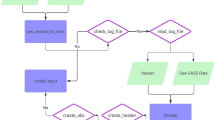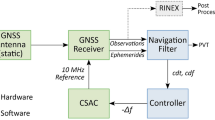Abstract.
This contribution is the third of four parts. Based on the gain-number concept, canonical forms will be presented of the ambiguity search spaces of the geometry-based model, the time-averaged model, and the geometry-free model. These forms reveal the intrinsic geometry of the search spaces and allow one to study their size, shape, and orientation as function of data precision, sampling rate, satellite redundancy, and change in receiver-satellite geometry. The canonical forms are also used to address the problem of search halting. The phenomenon of search halting is explained and it is shown how decorrelating ambiguity transformations can largely eliminate this computational burden.
Similar content being viewed by others
Author information
Authors and Affiliations
Additional information
Received: 16 July 1996 / Accepted: 14 November 1996
Rights and permissions
About this article
Cite this article
Teunissen, P. A canonical theory for short GPS baselines. Part III: the geometry of the ambiguity search space. Journal of Geodesy 71, 486–501 (1997). https://doi.org/10.1007/s001900050117
Issue Date:
DOI: https://doi.org/10.1007/s001900050117




